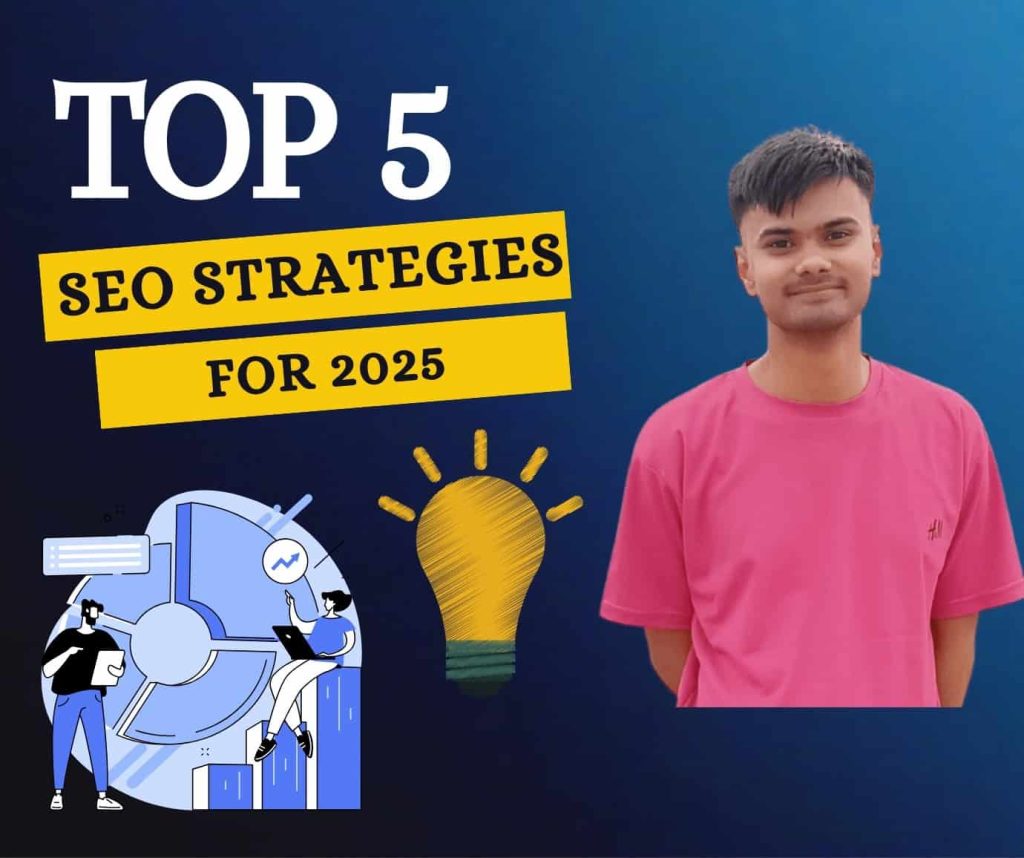The SEO landscape is evolving at lightning speed. As we head into 2025, staying ahead of the curve is no longer optional—it’s a survival tactic. Whether you’re an entrepreneur, blogger, or digital marketer, understanding the Top 5 SEO Strategies for 2025 will give you a competitive edge and help your content dominate search engine rankings.
You need to learn all these SEO strategies to become an SEO expert.
1. Embracing AI-Driven Content Optimization
Artificial Intelligence (AI) is revolutionizing how we create, optimize, and rank content. Gone are the days of manually analyzing keywords or relying solely on instinct. In 2025, AI is the secret weapon for SEO success.

How AI is Changing Search Behavior
Google’s algorithm is now heavily influenced by machine learning. BERT and MUM updates prioritize user intent and context. Search engines no longer just match keywords—they interpret meaning. Tools like OpenAI’s ChatGPT and Google’s SGE aim to provide nuanced, conversational responses.
Tools like ChatGPT, Surfer, and Jasper
Modern SEO professionals use AI-driven tools such as:
Surfer SEO: Helps optimize on-page SEO elements using NLP.
Jasper AI: Speeds up content creation while keeping SEO in mind.
ChatGPT: Assists with brainstorming, content briefs, and FAQs.
These tools reduce guesswork and enhance both quality and quantity of content output.
2. Core Web Vitals & Page Experience Signals
Page speed and user experience (UX) are no longer optional—they’re ranking signals. Google’s Core Web Vitals evaluate how well your page performs in terms of loading speed, interactivity, and visual stability. It is also one of the top 5 SEO strategies for 2025.

Understanding Google’s User-Centric Ranking
The three primary Core Web Vitals are:
Largest Contentful Paint (LCP) – How quickly content loads
First Input Delay (FID) – Time to interactivity
Cumulative Layout Shift (CLS) – Stability of layout as it loads
Google emphasizes these metrics because they mirror real-world user experiences.
Tips for Improving Core Metrics
Optimize images with next-gen formats like WebP.
Minify CSS and JavaScript.
Use lazy loading.
Implement a responsive design.
Choose a high-speed hosting provider.
Page performance improvements lead to better engagement and higher rankings.
3. E-E-A-T and Content Authenticity


In 2025, Google wants content written by real experts for real users. This is where E-E-A-T (Experience, Expertise, Authoritativeness, and Trustworthiness) becomes critical.
Experience, Expertise, Authoritativeness, and Trust
Google values content that reflects first-hand knowledge. If you’re writing about a product, show that you’ve actually used it. Include author bios, credentials, and citations from reliable sources.
Building Real Author Pages
Add detailed author bios with photos.
Link to social profiles and credentials.
Mention prior publications or awards.
The more transparent you are, the more likely your content is to rank.
4. Search Intent & Semantic SEO
In 2025, keyword stuffing is obsolete. What matters now is understanding search intent and writing content that aligns with it. It is the best top 5 SEO strategies for 2025.
Matching Content with User Intent
There are four types of search intent:
Informational: “How to start a podcast”
Navigational: “Spotify login”
Transactional: “Buy running shoes online”
Commercial Investigation: “Best budget laptops 2025”
Your content should match the intent to satisfy both the user and the algorithm.
Using NLP and Entities to Improve Relevance
Modern tools extract entities—like brands, locations, or topics—and relate them contextually. This helps search engines understand your content better and rank it more accurately.
Use structured data (schema) and relevant internal linking to boost semantic relevance.
5. Visual Search and Video SEO
Google Lens, Pinterest Lens, and TikTok search are transforming how people discover content. Visual search is growing, and optimizing for it will be key in 2025.
Rise of Image and Video Search
Users increasingly search using screenshots or images instead of text. Make your images searchable by:
Adding alt tags
Compressing image sizes
Using descriptive file names
YouTube SEO and Structured Data Optimization
Video content isn’t just for engagement—it’s SEO gold:
Add transcripts and captions
Optimize titles, tags, and descriptions
Use schema markup for video content
YouTube is the second-largest search engine—use it to your advantage.
